George Ivanovich Gurdjieff
G.I.Gurdjieff was a real mystery of the tragic 20th century. Very few people understood him and his mission, but many admired him, followed his ideas and regarded him a remarkable teacher and guide. It is no doubt that Gurdjieff has left one of the most important marks on humanity in our late history. Regarding his teaching, influence and outreach to hundreds of people, who were ready to start awakening, it is worthwhile for a serious seeker to pay close attention to his ideas and guidance.
Published on December 5, 2021
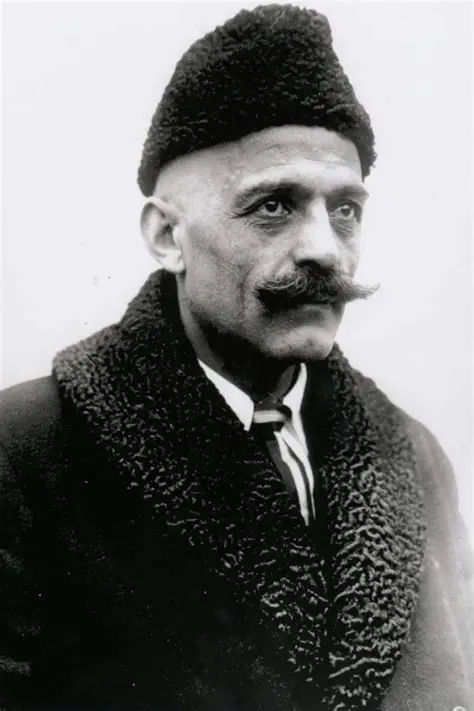
Gurdjieff’s grandmother to his grandson:
In life never do as others do. Either do nothing - just go to school - or do something nobody else does.1
Already in his early youth the main question arose in Gurdjieff’s mind and became the idee fixe of his inner world: What is the sense and significance of life on the earth in general and of human life in particular?. He was destined to answer such a fundamental question and guide others to the Path for finding out themselves.
Gurdjieff was an extraordinary man who made a profound impact upon those who met him even casually. He attracted widespread attention when he first came to Europe in the early 1920s. He founded a school in France, popularly known as the “forest philosophers”, and attracted a circle of remarkable men and women whose lives were changed by their contact with him. Through them, his ideas have penetrated into the world, particularly among the English-speaking people, and they have had more influence than many suspect.2
J.G.Bennett, one of his foremost pupils, has described his influence in the following:
A strikingly original thinker, who is far ahead of his time, makes an impact upon his immediate followers but is not understood or accepted by his contemporaries in general. A generation, or sometimes several, have to pass before an interest begins to awaken.3
Gurdjieff’s mission
It can be fairly said that Gurdjieff had a special mission on this planet. J.G.Bennet has stated that he gave him the impression of a man who had a well-defined program. Gurdjieff threaded his way through the complications of countries devastated by wars and revolution with the sense of complete assurance. He has stated that he was able to call on help from people who knew the importance of his task. He also gave the impression that he could and would establish his teaching institution where it was best for his mission.4 Gurdjieff was not concerned with the immediate present but with the impact that his work and ideas could have on the world over a long period of years and frequently referred to the realization of his aims after his death.5
In his Institute at the Chateau du Prieure near Avon in France, Gurdjieff accomplished something that had never been seen in modern Europe before. He created conditions for Work that enabled scores of people to discover and verify for themselves the potential for transformation that is latent in every human being. His method consisted of offering pupils the opportunity and means of stretching to the limit the capacities of their physical bodies for work, attention, the acquisition of skills, and the production of psychic energy.6
At the same time, Gurdjieff took deliberate measures to ensure that in his work and teaching activity he should not be made into a cult figure. His outrageous behaviour was one means he adopted for deflecting incipient hero-worship. He did not leave behind him either an embryo organization or a fixed teaching or a designated successor.7
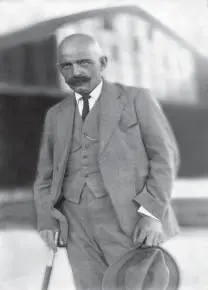 Gurdjieff said many times that the role of man on Earth is to be an
apparatus for transformation of energy; that certain energies that man
has to produce are required for cosmic purposes, and that those who
understand how these energies are produced are those who truly fulfil
the purpose of human life.8
This coincides with hylozoics, the teaching of Pythagoras, which
maintains that development depends on how much of higher energies can be
assimilated by individuals. Everybody receives the help that is
required for consciousness development. If we did not receive help “from
on high”, we could not even exist. Without help from higher kingdoms
the monads would not pass from a lower to a higher kingdom. But only a
fraction of this help is received consciously as almost everything
occurs in the unconscious.9
Gurdjieff said many times that the role of man on Earth is to be an
apparatus for transformation of energy; that certain energies that man
has to produce are required for cosmic purposes, and that those who
understand how these energies are produced are those who truly fulfil
the purpose of human life.8
This coincides with hylozoics, the teaching of Pythagoras, which
maintains that development depends on how much of higher energies can be
assimilated by individuals. Everybody receives the help that is
required for consciousness development. If we did not receive help “from
on high”, we could not even exist. Without help from higher kingdoms
the monads would not pass from a lower to a higher kingdom. But only a
fraction of this help is received consciously as almost everything
occurs in the unconscious.9
Alice A. Bailey (D.K.) has described the educational and mental work that has been going on amongst humanity in our recent past. It is probable that Gurdjieff is the one mentioned in below as an “an initiate”:
The head of the third main department of the planetary hierarchy, 43-self R., is working upon this problem, and likewise a 45-self of English nationality. They are aided by a disciple of rare capability in Sweden, and by an initiate in the southern part of Russia, who works much in the mental world. Their aim is so to tap the resources of force stored up by the nirmanakayas that its downflow may sweep out lower kinds of matter, and thus permit the free play of higher vibrations.10
The Fourth Way - The Way of the Sly Man
Gurdjieff’s teachings were clearly practical, which showed to students that the attainment of higher levels of consciousness and being is possible given the conditions and the readiness to commit oneself to work for it. The harmonious development of man, as conveyed by him, is an extraordinary process that makes it possible for us to go beyond the limitations of our ordinary human nature, to enter different states of consciousness, to acquire new powers of understanding, and to go beyond the conditioning of our earthly existence.11
In Gurdjieff’s view, all existing and generally known ways to the development of man’s hidden possibilities can be divided into three categories:
The way of the fakir - the way of struggle with the physical body.
The way of the monk - the way of faith, the way of religious feeling, religious sacrifice.
The way of the yogi - the way of knowledge, the way of mind.
Those ways have all their limitations, as they consider just one part of man’s being at a time. The fakir is master of his body but not of his emotions or his mind; the monk is master of his emotions but not of his body or his mind; the yogi is master of his mind but not of his body or his emotions. At the same time, the suffering and hardships those ways go through show us how difficult and rare such development is.
But there is also the fourth way, the way of a “sly man”. The sly man has become to know some secret for development, which the fakir, monk, and yogi do not know. The sly man knows more and with its help outstrips the fakir, the monk, and the yogi.
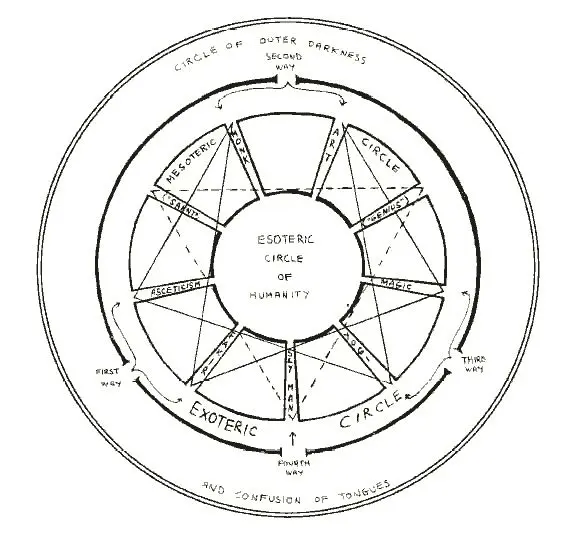
The way of the sly man has no definite forms like the ways of the fakir, the monk, and the yogi. And, first of all - this way has to be found, which is the first test. It is not as well known as the three traditional ways. There are many people who have never heard of the fourth way and there are others who deny its existence or possibility.
The fourth way affects simultaneously every side of man’s being. It is work on his physical, his emotional and mental. It also makes the principal demand for understanding: a man must do nothing that he does not understand. The more a man understands what he is doing, the greater will be the results of his efforts.
Also, on the fourth way it is possible to work and to follow this way while remaining in the usual conditions of life: continuing to do the usual work, preserving former relations with people, and without renouncing or giving up anything. On the contrary, the conditions of life in which a man is placed are the best possible for him, at any rate at the beginning of the work.12
Gurdjieff considered a mark of a perfected man to be his ability to play to perfection any desired role in his external life while inwardly remaining free and not allowing himself to “blend” with anything proceeding outside of him.13
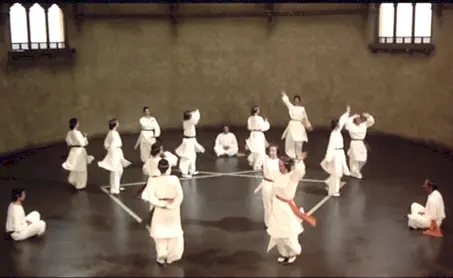
Part of the fourth way method were also specific movements and dances14 that Gurdjieff taught to his pupils. He explained that his system developed all sides of a man’s nature, and that the exercises were not only to acquire control of the physical body, but they included complicated patterns that called for a powerful effort of mental attention. In combination with the mime they acted upon the emotional nature. A very severe training of body, mind and feelings is required to enable the ritual movements to be carried out correctly. In Gurdjieff’s exercises, the individual must be itself in a high state of consciousness that unites three functions of thought, feelings and bodily sensation into a single integral act of expression.15
Man is a machine and in prison
Gurdjieff conveyed an essential message to our present mankind, which has been understood just by the few. He stated that man, such as we know him, is a machine.16 That things “just happen to him” without his willing or controlling it. Mechanicalness thus is his being. All his deeds, actions, words, thoughts, feelings, convictions, opinions, and habits are the results of external influences, external impressions. Out of himself a man cannot produce a single thought, a single action. Everything he says, does, thinks, feels — all this happens. Man cannot discover anything, invent anything. It all happens.17
This is a crucial insight conveyed by Gurdjieff to the Western world in the 20th century as it describes the unfortunate state of modern man and demystifies the impression of man being gloriously the “crown of evolution”. It also lays the basis for real developing of consciousness and being, which was central in his teaching.
Gurdjieff maintained that observing human psychic activities clearly demonstrates that the modern man never acts of his own accord, but only manifests actions stimulated by external irritations. Modern man does not think, but something thinks for him; he does not act, but something acts through him; he does not create, but something is created through him; he does not achieve, but something is achieved through him.18
Gurdjieff described the situation of normal man as being in prison of his own mechanicalness - his lower feelings and thoughts. Ordinary man is not able to be self-conscious, therefore he is not able to receive higher energies for furthering his development. If a man in prison was to have a chance of escape, then he must first of all realize that he is in prison. So long as he fails to realize this, so long as he thinks he is free, he has no chance whatever. No one can help or liberate himself against his so-called will, in opposition to his wishes. Liberation is possible only as a result of great labor and great efforts, and above all, of conscious efforts, towards a definite aim.

All a sensible man can wish for is to escape. But how to escape? It is necessary to dig tunnel under a wall. And in this, one man can do nothing. But several men together can achieve – if they work in turn and if one covers another they can complete the tunnel and escape. But no one can escape from prison without the help of those who have escaped before. Only they can say in what way escape is possible or can send tools, files, or whatever may be necessary. But one prisoner alone cannot find these people or get into touch with them. An organization is necessary as nothing can be achieved without an organization (school).19
Gurdjieff emphasized that in order for man to develop his hidden capacities and powers, he has to clean his machine of the dirt that has clogged it in the course of his life. But in order to undertake this cleaning in a rational way, he has to see what needs to be cleaned, where and how; but to see this for himself is almost impossible. For him to see anything of this, he has to look from outside, and for this mutual help is necessary.20
False personality
If man receives such help and wants to get to know himself, then he should start observing himself, which is not easy at all. And self-observation must be based on an exact knowledge of man’s real nature, what constitutes his being and how this being can be divided. When he his diligent enough and works hardly on self-observation, then he finds out, that he is not a unitary being, but has many mechanical “I”'s in him - the division into hundreds of different “I”'s grouped into a small number of personalities.
Beside small number of “I”'s, which are capable of development, man has a false personality. False personality is the sum total of everything that cannot develop, everything that cannot be part of the development of our consciousness, that which is the most deeply asleep and wants to drag along with itself everything that is more awake. In most people, who are not interested in consciousness development, false personality keeps control over the individual and is quite calm. Gurdjieff constantly said that: “Like what it (false personality) does not like.”
Negative emotions
As soon as a man awakens to the need of developing consciousness and begins to make efforts to that end, false personality becomes more active. It starts to defend itself, for it knows instinctively that to the extent the man has success in his work at developing, to the same extent false personality must grow weaker. The most important elements of false personality are negative emotions. Ordinary man is under their power. If we can effectively reduce the existence and power of negative emotions in us, we shall be able to develop our consciousness. When we no longer have negative emotions, we shall be able to acquire truly positive emotions. We do not have them yet.21
Gurdjieff stressed that in order to achieve something, man needs to separate himself from himself. Without this nothing happens and no one can help him. To govern oneself is a very difficult thing - it is a problem of the future; it needs much power and demands much work. But this first thing, to separate oneself from oneself, does not require much strength, but needs mainly serious wish - the wish of a responsible man. If a man cannot do it, this shows that he lacks such a wish. Our feelings and thinking have nothing in common with our real selves. Usually our thinking is the result of our feelings and man has little control over his feelings. When I say “to separate oneself from oneself”, it means first of all that our mind should stand apart from our feelings.22
Gurdjieff explained on his teaching principle that his wish was to create around himself conditions in which a man would be continually reminded of the sense and aim of his existence by an unavoidable friction between his conscience and the automatic manifestations of his nature.23 He acted consistently in all his various experiments with people in his plan to set up a system of training and personal development that would produce “free” men and women.24
War on sleep
The fourth way is the way of the war on sleep. Gurdjieff explained that ordinary man is living in the lowest states of his consciousness. Man exists just in two “modes” - organic sleep at night and being so-called awake at daytime. But there are at least four states of consciousness possible for man and the highest ones man can reach only with conscious striving and by work and toil - the state of self-consciousness and the state of objective consciousness.
In reality, what is normally called a state of wakefulness, is also a kind of sleep. Ordinary man is a machine, everything with him happens. He cannot stop the flow of his thoughts, he cannot control his imagination, his emotions, his attention. He lives in a subjective world of “I love,” “I do not love,” “I like,” “I do not like,” “I want,” “I do not want,” etc. He does not see the real world. The real world is hidden from him by the wall of imagination. He lives in sleep and is asleep. What is called “clear consciousness” is sleep.25
The core practice against such a sleep is self-observation, which should lead to self-remembrance. Self-remembering can then create moments of the third state of consciousness, namely self-consciousness, which means to be intensely present here and now.
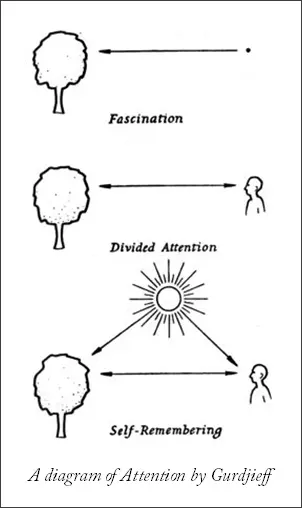
Self-remembrance
Remembering oneself means the same as being conscious of oneself – “I am”. It is no function, no thought, no feeling, but another state of consciousness. Usually we are hardly attentive at all or our attention jumps about, staying very briefly at different objects without being directed or controlled by our intention. At other occasions our attention can be attracted by some object that captivates, fascinates us, an exciting film, for instance. Seldom our attention is directed from within ourselves.
If, simultaneously as you direct your attention at an outer or inner object, you direct your attention at yourself, then you have doubly-directed attention. Then you “remember yourself”, which can lead you to become self-conscious. This can be represented graphically by an arrow that is pointed in both ends.
But you cannot just make up your mind to remember yourself starting from your ordinary state. There is a certain feeling always connected with self-remembrance. It is necessary to get into a certain state to begin with, a certain frame of mind, and then do it from there. Reflection on “cosmic ideas”, esoteric truths, may create such a state.26
Self-remembering is a practical thing, which you can understand only if you who have some practical experience of it, and the better the more extensive your practice is. You must have experienced it, not just once, but many times in different connections, various situations, so that you have a sufficiently large material of experience of it. Only then will you appreciate, in a deep way, beyond a mere shallow fascination, its immense significance.27
Self-remembrance as a practice in Sufism is known as zikr, meaning “remembrance”. It is a directing of the intention and the will toward the deity within.28
Effort
An important cornerstone of Gurdjieff’s teaching was effort and more effort. He emphasized this frequently to his pupils: “Vast efforts, tremendous labours, are needed to come into possession of the wings on which it is possible to rise.”29 Also, “No growth is possible,” he would say, “without conscious labour and intentional suffering.” By this he meant that we cannot attain something without payment, or sacrifice - not in the sense of morbid self-punishment, but rather in the necessity of giving something up in order to make space for something new. What we “give up” can be something intangible like low self-worth, or even laziness, or some other character defect like vanity or pride.
He even introduced a new term, partkdolgduty30, to emphasize the importance of effort and suffering. It is the word “obligation” in three different languages - Armenian, Russian and English - put together. He explained that intentional suffering means to expose oneself to painful situations in order to help others, especially situations caused by the negative manifestations of those one is trying to help. For instance, in his main book Beelzebub’s Tales to His Grandson, almost all the heroes are said to have undertaken partkdolgduty in order to acquire knowledge that would help mankind, especially future generations.31
The connection between Gurdjieff and the teaching of Pythagoras
Gurdjieff had a special attitude and relationship to Pythagoras. For instance, in his book Beelzebub’s Tales to His Grandson, he names Pythagoras as one of the two learned wise men and “initiates of the first degree”, who initiated the Club of the Adherents of Legomonism. According to J.G.Bennett, Gurdjieff to some extent modeled his Institute upon the Pythagorean Schools.32 He also drew his teaching on the Pythagorean tradition, e.g. in adapting the doctrine of “different worlds” or cosmoses.33
Pythagoras’ ideas are recognizable in several instances through Gurdjieff teaching. One of Gurdjieff’s basic ideas was that everything in the universe is material34, everything is energy, and everything is undergoing processes of transformation.35 This coincides closely with hylozoics, the teaching of Pythagoras’ basic tenet that reality has three aspects: matter, consciousness and motion.
Gurdjieff maintained that the language of numbers alone can serve for an exact expression of thought and knowledge, both in quantity and quality. One of the tasks of his teaching is to bring our thinking nearer to an exact mathematical designation of things and events and to give to men the possibility of understanding themselves and each other.36
The numbers 3 and 7 appear frequently in Gurdjieff’s teaching, also the number 49 is mentioned. He formulated the first cosmic law - the law of sevenfoldness or using his term Heptaparaparshinokh - and in that the Pythagoreans are one of the main sources for the reconstruction of this law.37 He maintained that everything is arranged in octaves (seven notes), each octave being one note of a greater octave, until you come to the Cosmic Octave.38
The law of threefoldness as the second cosmic law formulated by Gurdjieff is the so-called Triamazikamno, which consists of three independent forces and this law manifests itself everywhere and in everything in the Universe, without exception, in three separate and independent aspects. The first aspect is affirming, the second denying and the third reconciling.39 Also, according to the law of threefoldness, matter constantly enters into various combinations, becomes more dense, meets with other matter and becomes still denser, thus changing all its properties and possibilities. For instance, in the higher spheres, intelligence is in its purest form, but as it descends it becomes less intelligent.40
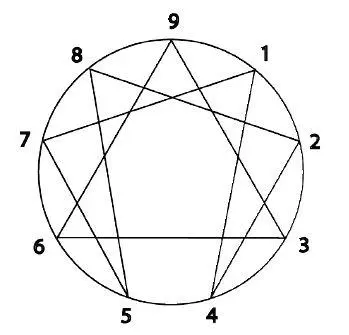
J.G.Bennett has said that when they came to learn the sacred dances, they discovered that some of the most significant were based on combinations of the laws of three and seven, and in particular, on the enneagram symbol.41
Number 49 appears for instance in Gurdjieff’s description of the Cosmos being an octave of seven notes, each note of which can be subdivided into a further octave, and again and again to the uttermost divisibe atom.42 Also Gurdjieff used this number in his symbolic description of the “apparatuses”, which were used to train priestesses-dancers in the secret Sarmoung monastery. Those apparatuses were of very ancient workmanship and made of “ebony and inlaid with ivory and mother-of-pearl”. Apparatuses had a vertical column to which were fitted seven moveable arms, and each of these arms was provided with seven universal joints similar to those of the human shoulder. Each of the forty-nine joints and the ends carried a sign. Associated with the apparatuses were “golden plates”, which carried the message - the postures and gestures of the dancers.43 The dance thus became an utterance, the language which was known to the brethren and enabled them to read truths placed there thousands of years before.44
According to Pythagorean teaching - hylozoics -, there are three equivalent aspects of reality. All our existence is permeated by three aspects, which are:
- matter aspect,
- consciousness aspect and
- motion aspect.
None of these three can exist without the other two. All matter is in motion and has consciousness.
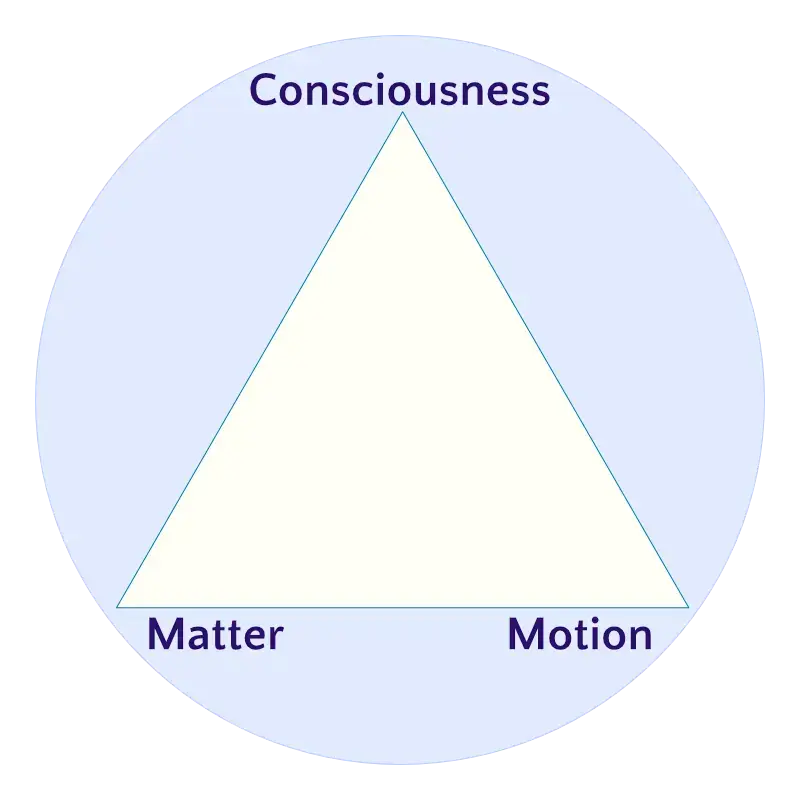
Our cosmos, which is composed of primordial atoms called monads, consists of 49 atomic worlds altogether. These worlds are divided into seven series of seven worlds in each series. The division into septenaries is due to the fact that the three aspects of existence have been susceptible of combination in seven different ways.
These 49 different atomic kinds make up 49 cosmic worlds of increasingly greater density. As matter is thus composed, all the higher worlds can penetrate all the lower worlds. All the 49 atomic worlds occupy the same space in the cosmos and fill up the cosmic globe.45
The seven highest cosmic worlds (1-7) constitute the foundation of everything in the cosmos. From the seven highest cosmic worlds emanate all the material energies which form matter and the worlds and make the cosmos a living whole constantly changing.46
Gurdjieff carried with him such knowledge, e.g. by stating that …Great, all-embracing is the law of unity. Everything in the Universe is one, the difference is only of scale; in the infinitely smalle we shall find the same laws as in the infinitely great. As above, so below.47
Relation to the Ancient Wisdom schools
Gurdjieff is known for his hints and indications of the Ancient Wisdom schools. He was certain already at the age of fourteen that there really was “a certain something” which people formerly knew, but that now this knowledge was quite forgotten.48
He insisted that real knowledge was not hidden, but that, on the contrary, those who possessed it were deeply concerned to make it available to those who could receive it and use it wisely. They are doing everything they can to transmit and communicate it to the greatest possible number of people, to facilitate people’s approach to it and enable them to prepare themselves to receive the truth. But the acquisition or transmission of true knowledge demands great labor and great effort both of him who receives and of him who gives.49
Gurdjieff in several instances referred to the importance of having a teacher. His firm conviction was that every man, who is interested in becoming more conscious, must have a teacher. He also said that he himself had a teacher, he was never separated from him and that he was in constant communication with his teacher.50 Gurdjieff spoke in several occasions to his close pupils about schools in central Asia with which he was in communication and to whom he sent specially prepared pupils.51 As a teacher, Gurdjieff described a teaching practice that he had followed all his life - namely to give pupils what they are able to receive.52
J.G.Bennett has recorded a special conversation with Gurdjieff, who some months before his death in 1949 said that an organization of a higher order was being established in the world that would be able to accept only those who had reached such a stage of spiritual development that they were able to generate higher energies. Those who were able to communicate with and draw upon this organization would themselves have to be able to participate in this work of generating and transmitting higher energies.53
Tzvarnoharno
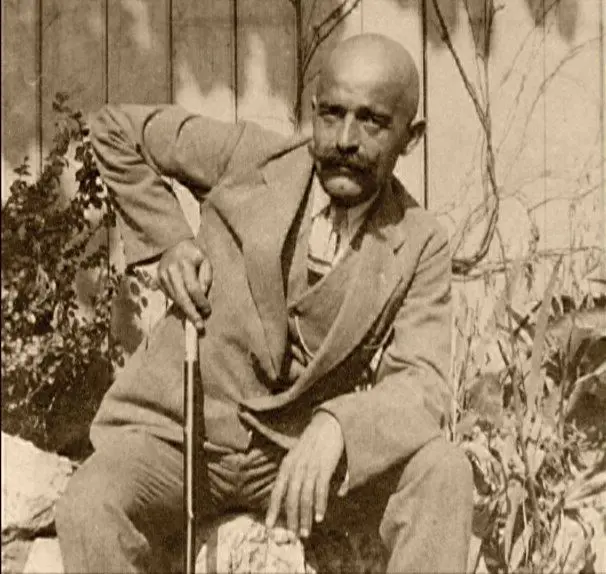
As has happened with several great contributors to the development and welfare of humanity, Gurdjieff also experienced strong setbacks in his life. On July 6, 1924, when he was fourty-seven years old, he crashed with a car going at ninety kilometres an hour into a great tree alongside the road in Fointainebleau forest. As G.I.Bennett has put it: “Almost any other other man would have died from the injuries he received.”54 He was so close to death that the doctors warned his family that there was little or no chance of his surviving. Gurdjieff survived and gradually through a lot of effort restored his health, but was forced to abandon his long-term plans to set up a world organization to promulgate his ideas - to establish branches of his Institute in order to train teachers and instructors.
It is highly likely that it was not just ordinary accident, but something was behind it to happen and influence his future. Gurdjieff spoke of his motor accident as the manifestation of a power hostile to his aim, a power with which he could not contend. He decided that he must change all his plans.55
In this context it is worthwhile to note a special term - tzvarnoharno - that he used to describe such phenomena, which can counteract those who make strong contributions for humanity as a whole.
Gurdjieff has explained that tzvarnoharno is that “something”, which forms itself by a natural process in the communal life of people as an outcome of a conjunction of the evil actions of so-called “common people” and leads to the destruction of both him that tries to achieve something for general human welfare and of all that he has already accomplished to this end.56
Probably every single great contributor has had similar kind of blowbacks and hindrances. Which tells much about the condition and state our humanity is and has been in our recent past.
One of the strongest motives for wishing to work on yourself is the realization that you may die at any moment.57
G.I.Gurdjieff Beelzebub’s Tales to His Grandson: An Objectively Impartial Criticism of the Life of Man (1950), chapter 1, p 27 ↩︎
J.G.Bennett Gurdjieff: Making a New World (1992), p 1 ↩︎
Ibid, p 2 ↩︎
Ibid, p 101 ↩︎
Ibid, p 133 ↩︎
Ibid, p 118 ↩︎
Ibid, pp 4-5 ↩︎
Ibid, p 58 ↩︎
Henry T. Laurency The Way of Man, Nine: The Second Self, 9.72 ↩︎
Alice A. Bailey The Way of the Disciple, part One, 4.21 ↩︎
J.G.Bennett Gurdjieff: Making a New World (1992), p 188 ↩︎
P.D.Ouspensky In Search of the Miraculous (1949), pp 51-56 (pdf) ↩︎
J.G.Bennett Gurdjieff: Making a New World (1992), p 86 ↩︎
Some instances of such movements can be viewed here and here ↩︎
J.G.Bennett Gurdjieff: Making a New World (1992), p 99 ↩︎
G.I.Gurdjieff Views from the Real World (1973), chapter II: For an Exact Study, Exact Language is Needed… ↩︎
P.D.Ouspensky In Search of the Miraculous (1949), p 19 ↩︎
G.I.Gurdjieff The Herald of Coming Good (1933), p 27 ↩︎
P.D.Ouspensky In Search of the Miraculous (1949), p 28 ↩︎
G.I.Gurdjieff Views from the Real World (1973), chapter II: When Speaking on Different Subjects… ↩︎
L.Adelskogh The Fourth Way, part 1 (2000), p 11 (rtf). Published on hylozoik.se ↩︎
G.I.Gurdjieff lecture in the Prieure on February 8, 1923 - recorded by J.G.Bennett in Gurdjieff: Making a New World (1992), p 109 ↩︎
G.I.Gurdjieff Meetings with Remarkable Men (1963), p 270 ↩︎
J.G.Bennett Gurdjieff: Making a New World (1992), p 93 ↩︎
P.D.Ouspensky In Search of the Miraculous (1949), p 150 (pdf) ↩︎
L.Adelskogh “Self-Remembrance”, 16.4.8. Published on http://hylozoik.se/ ↩︎
L.Adelskogh The Fourth Way, part 1 (2000), p 7 (pdf). Published on hylozoik.se ↩︎
J.G.Bennett Gurdjieff: Making a New World (1992), p 170 ↩︎
G.I.Gurdjieff Views from the Real World (1973), chapter I: Glimpses of Truth ↩︎
In his book Beelzebub’s Tales to His Grandson: An Objectively Impartial Criticism of the Life of Man (1950) ↩︎
J.G.Bennett Gurdjieff: Making a New World (1992), pp 171-172 ↩︎
Ibid, p 45 ↩︎
Ibid, p 152 ↩︎
G.I.Gurdjieff Views from the Real World (1973), chapter I: Glimpses of Truth ↩︎
J.G.Bennett Gurdjieff: Making a New World (1992), p 153 ↩︎
G.I.Gurdjieff Views from the Real World (1973), chapter II: For an Exact Study, Exact Language is Needed… ↩︎
J.G.Bennett Gurdjieff: Making a New World (1992), p 174 ↩︎
G.I.Gurdjieff Views from the Real World (1973), chapter III: Questions and Answers on Art etc… ↩︎
G.I.Gurdjieff Beelzebub’s Tales to His Grandson: An Objectively Impartial Criticism of the Life of Man (1950), p 132 (pdf) ↩︎
G.I.Gurdjieff Views from the Real World (1973), chapter IV: Everywhere and Always There is Affirmation and Negation… ↩︎
J.G.Bennett Gurdjieff: Making a New World (1992), p 82 ↩︎
G.I.Gurdjieff Views from the Real World (1973), chapter III: Questions and Answers on Art etc… ↩︎
G.I.Gurdjieff Meetings with Remarkable Men (1963), p 164 ↩︎
J.G.Bennett Gurdjieff: Making a New World (1992), p 50 ↩︎
Henry T. Laurency The Knowledge of Reality (1979), 2.2.1-2.2.2 ↩︎
Ibid, 2.11.7 ↩︎
G.I.Gurdjieff Views from the Real World (1973), chapter I: Glimpses of Truth ↩︎
G.I.Gurdjieff Meetings with Remarkable Men (1963), p 89 ↩︎
P.D.Ouspensky In Search of the Miraculous (1949), p 37 ↩︎
Ibid, p 61 ↩︎
Ibid, p 84 ↩︎
Ibid, p 87 ↩︎
Ibid, p 59 ↩︎
Ibid, p 122 ↩︎
Ibid, p 127 ↩︎
G.I.Gurdjieff The Herald of Coming Good (1933), p 8 ↩︎
One of Gurdjieff’s sayings on the wall of his Institute at the Chateau du Prieure in Avon, France ↩︎

